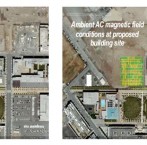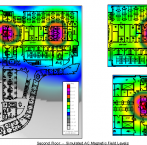EMI Threat Risk Assessment
This 235,000 GSF “Neuroscience Laboratory & Clinical Research Building” scheduled for completion in 2011 on the University of California San Francisco campus will house laboratories and clinical research space to support 100 clinical researchers engaged in the University’s Program for Neurologic Disease Research. SOM, the project’s architect, engaged FMS to conduct a thorough EMI threat risk assessment of the proposed building site and to review the building’s design documents to ensure that neither existing EMF conditions or potential EMF sources in the building would present an interference risk to a variety of advanced, sensitive research equipment planned for use in the building.
FMS provided the project’s design and construction teams with critical information to materially reduce EMI mitigation expense for building and its planned site while ensuring optimum operating conditions for sensitive equipment planned for use in the building without risk of expensive and disruptive post construction mitigation measures.
Assessment of existing EMI conditions at the proposed building site – EMF Broadband Survey
Prior to SOM finalizing the building’s design, FMS conducted a broadband EMI survey at the proposed building site to document existing DC, AC and RF magnetic field strength conditions. Spot and time measurement data of steady-state and transient conditions were analyzed to determine EMI threat potential from sources external to the site. The building’s design team and lab planners utilized the EMI threat risk assessment findings to guide placement of sensitive equipment in areas of the building which materially alleviated the need for costly measures to mitigate serious EMI, such as the installation of shielding.
EMI threat sources identified by review of project’s design drawings and documents
FMS’ extensive review of the project’s design and construction documents identified potential internal EMI sources, including the building’s electrical substation and high current distribution equipment. In addition area electrical rooms with transformers, breaker panels and high current vertical bus ducts were identified as potential EMI sources.
AC magnetic field emissions evaluated by computer model of EMI threat sources
Computer simulation models of AC magnetic field emissions from the identified high current electrical system components including the Ground Floor electrical substation indicated that elevated AC magnetic field levels would be present in areas of the Second Floor, immediately above the main electrical equipment. The computer simulation studies also indicated that elevated AC magnetic field levels may be present on each floor of the building in areas immediately adjacent to the vertical bus duct riser. These computer simulation projections of magnetic field conditions allowed the project’s architect and lab planners to place sensitive equipment sufficient distance from the identified EMI sources to mitigate EMI threat concerns to the equipment – a cost effective, low cost measure as opposed to expensive shielding.
Recommended magnetic field shielding to mitigate EMI threat potential
Computer simulation studies indicated that high AC magnetic field levels would likely be present in areas adjacent to and above the Ground Floor electrical substation and main electrical distribution equipment. As a consequence, large areas of the Ground and Second Floor near the electrical equipment may not be suitable for use of sensitive research equipment sensitive to EMI. To make these areas suitable for sensitive equipment use, FMS recommended implementation of a shielding scheme utilizing highly conductive shielding material installed on the ceiling and all four walls of the Ground Floor Main Electrical Room.
The ambient site EM measurements (DC field shifts from nearby light rail) and computer simulation studies of the building’s electrical distribution system indicated that the planned future installation of a sensitive electron microscope could be subject to EMI threat conditions. FMS recommended that when the microscope is acquired, robust AC and DC magnetic field shielding be installed in the room prior to setting up the microscope system to mitigate EMI threats. As a cost reduction measure, FMS recommended that certain preparatory items be included in the room’s construction to facilitate the future installation of the recommend shielding.

Over its 20 years, FMS has successfully completed hundreds of EMI projects which included a diverse range of consulting and mitigation services.
Take a look at a list of the markets we serve »













